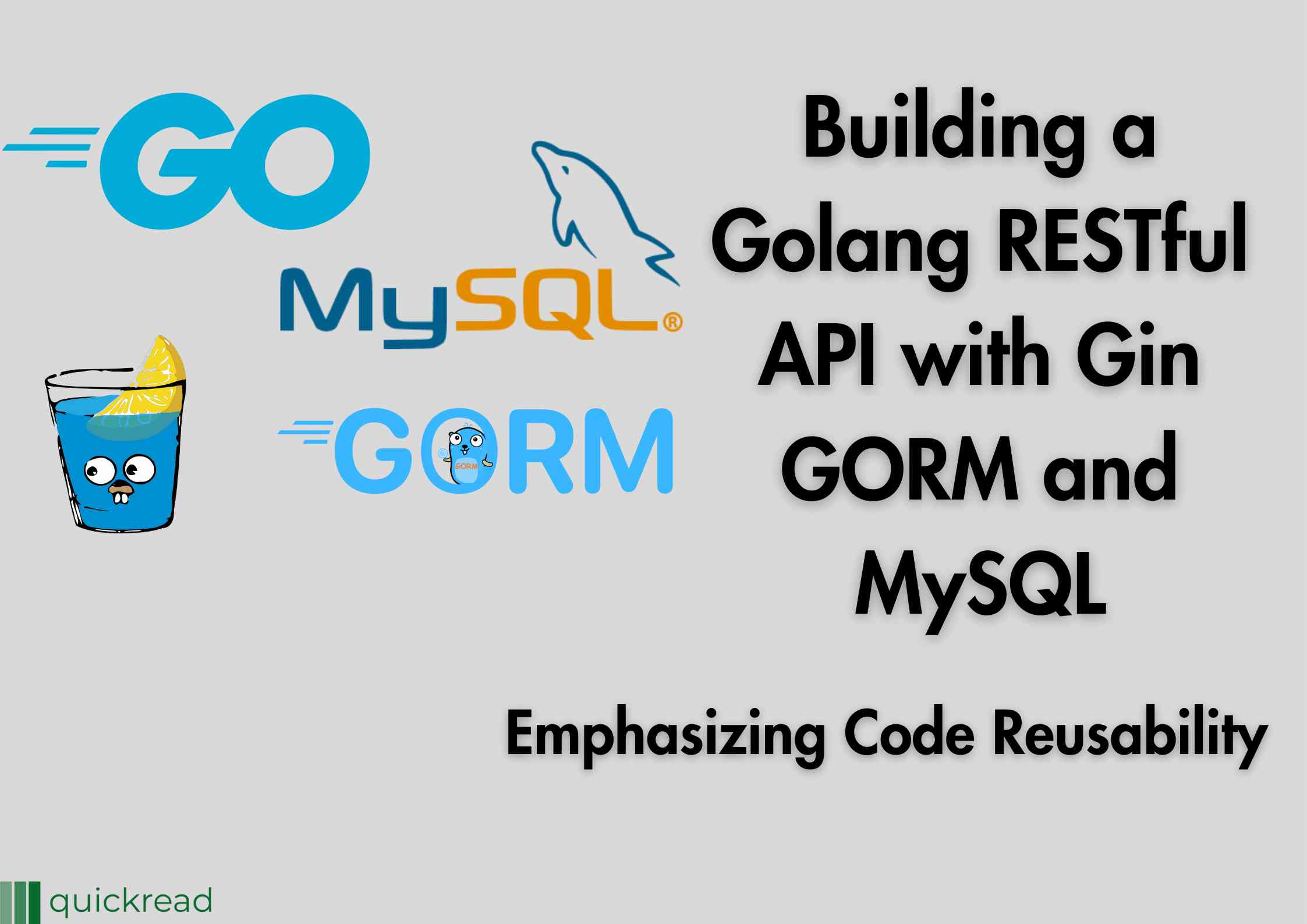Last updated on August 5th, 2023
Introduction Golang RESTful API with Gin GORM and MySQL
Golang RESTful API with Gin GORM and MySQL: Gin is a strong and compact web framework for Golang, and GORM is a well-known object-relational mapping package that makes it easier to connect with databases. In this tutorial, we’ll show you how to build a RESTful API with Gin, GORM, and a MySQL database. To make your programme more scalable and maintainable, we’ll also concentrate on preserving code reuse.
Prerequisites
Before we proceed, ensure you have the following installed on your machine:
- Go programming language: official website
- MySQL database: Official Website
- Gin and GORM packages: Open your terminal and run the following commands:
go get -u github.com/gin-gonic/gin
go get -u gorm.io/gorm
go get -u gorm.io/driver/mysql
Setup Steps
- Create a new Golang project
Open your terminal and create a new folder for your project. Inside the folder, create a new Go module:
mkdir my-gin-api
cd my-gin-api
go mod init my-gin-api
- Import required packages
Next, open your main.go file and import the necessary packages:
package main
import (
"github.com/gin-gonic/gin"
"gorm.io/driver/mysql"
"gorm.io/gorm"
)
- Create database connection
Now, let’s create a function to establish a connection to the MySQL database. Replace the connection details with your MySQL credentials:
func connectDB() (*gorm.DB, error) {
dsn := "user:password@tcp(127.0.0.1:3306)/database_name?charset=utf8mb4&parseTime=True&loc=Local"
db, err := gorm.Open(mysql.Open(dsn), &gorm.Config{})
if err != nil {
return nil, err
}
return db, nil
}
- Define a reusable model structure
To ensure code reusability, let’s create a separate file called models.go to define the model structure. For example, if we’re building a simple user application, the structure could be:
package main
import "gorm.io/gorm"
type User struct {
gorm.Model
Name string `json:"name"`
Email string `json:"email"`
}
- Implement CRUD operations
Now, let’s create a file named crud.go where we’ll implement the CRUD operations:
package main
import (
"github.com/gin-gonic/gin"
"gorm.io/gorm"
)
// Function to create a new user
func createUser(c *gin.Context) {
db, err := connectDB()
if err != nil {
c.JSON(500, gin.H{"error": "Database connection error"})
return
}
defer db.Close()
var user User
if err := c.ShouldBindJSON(&user); err != nil {
c.JSON(400, gin.H{"error": "Invalid data"})
return
}
result := db.Create(&user)
if result.Error != nil {
c.JSON(500, gin.H{"error": "Failed to create user"})
return
}
c.JSON(201, user)
}
// Function to get all users
func getUsers(c *gin.Context) {
db, err := connectDB()
if err != nil {
c.JSON(500, gin.H{"error": "Database connection error"})
return
}
defer db.Close()
var users []User
db.Find(&users)
c.JSON(200, users)
}
// Function to update a user
func updateUser(c *gin.Context) {
db, err := connectDB()
if err != nil {
c.JSON(500, gin.H{"error": "Database connection error"})
return
}
defer db.Close()
id := c.Param("id")
var user User
db.First(&user, id)
if err := c.ShouldBindJSON(&user); err != nil {
c.JSON(400, gin.H{"error": "Invalid data"})
return
}
db.Save(&user)
c.JSON(200, user)
}
// Function to delete a user
func deleteUser(c *gin.Context) {
db, err := connectDB()
if err != nil {
c.JSON(500, gin.H{"error": "Database connection error"})
return
}
defer db.Close()
id := c.Param("id")
var user User
db.Delete(&user, id)
c.JSON(200, gin.H{"message": "User successfully deleted"})
}
- Implement routing
Now, let’s define the routes in the main.go file to call the CRUD functions:
func main() {
app := gin.Default()
// Routes
app.POST("/users", createUser)
app.GET("/users", getUsers)
app.PUT("/users/:id", updateUser)
app.DELETE("/users/:id", deleteUser)
// Start server
app.Run(":3000")
}
- Run the application
Finally, start the server by running:
go run .
Application Outputs and Descriptions
- Creating a New User:
To create a new user, make a POST request to the “/users” endpoint with a JSON payload containing the user details. For example:
Request:
POST /users
{
"name": "John Doe",
"email": "john.doe@example.com"
}
Response:
Status: 201 Created
{
"ID": 1,
"CreatedAt": "2023-07-25T10:00:00Z",
"UpdatedAt": "2023-07-25T10:00:00Z",
"DeletedAt": null,
"name": "John Doe",
"email": "john.doe@example.com"
}
- Retrieving All Users:
To retrieve all users, make a GET request to the “/users” endpoint. The server will respond with a JSON array containing all the users.
Request:
GET /users
Response:
Status: 200 OK
[
{
"ID": 1,
"CreatedAt": "2023-07-25T10:00:00Z",
"UpdatedAt": "2023-07-25T10:00:00Z",
"DeletedAt": null,
"name": "John Doe",
"email": "john.doe@example.com"
},
{
"ID": 2,
"CreatedAt": "2023-07-26T08:30:00Z",
"UpdatedAt": "2023-07-26T08:30:00Z",
"DeletedAt": null,
"name": "Jane Smith",
"email": "jane.smith@example.com"
}
]
- Updating a User:
To update a user, make a PUT request to the “/users/{id}” endpoint, where “{id}” is the ID of the user you want to update. Provide a JSON payload with the updated user details.
Request:
PUT /users/1
{
"name": "John Doe Updated",
"email": "john.updated@example.com"
}
Response:
Status: 200 OK
{
"ID": 1,
"CreatedAt": "2023-07-25T10:00:00Z",
"UpdatedAt": "2023-07-27T15:45:00Z",
"DeletedAt": null,
"name": "John Doe Updated",
"email": "john.updated@example.com"
}
- Deleting a User:
To delete a user, make a DELETE request to the “/users/{id}” endpoint, where “{id}” is the ID of the user you want to delete.
Request:
DELETE /users/2
Response:
Status: 200 OK
{
"message": "User successfully deleted"
}
Conclusion
In this article, we demonstrated how to build a Golang RESTful API using Gin and GORM with a MySQL database. By creating a reusable model structure and separating the database logic, we emphasized code reusability, making your application more scalable and maintainable. The step-by-step setup instructions should help you easily set up the project on your own machine. Now you can build efficient and powerful APIs with Golang, Gin, and GORM. Happy coding!


